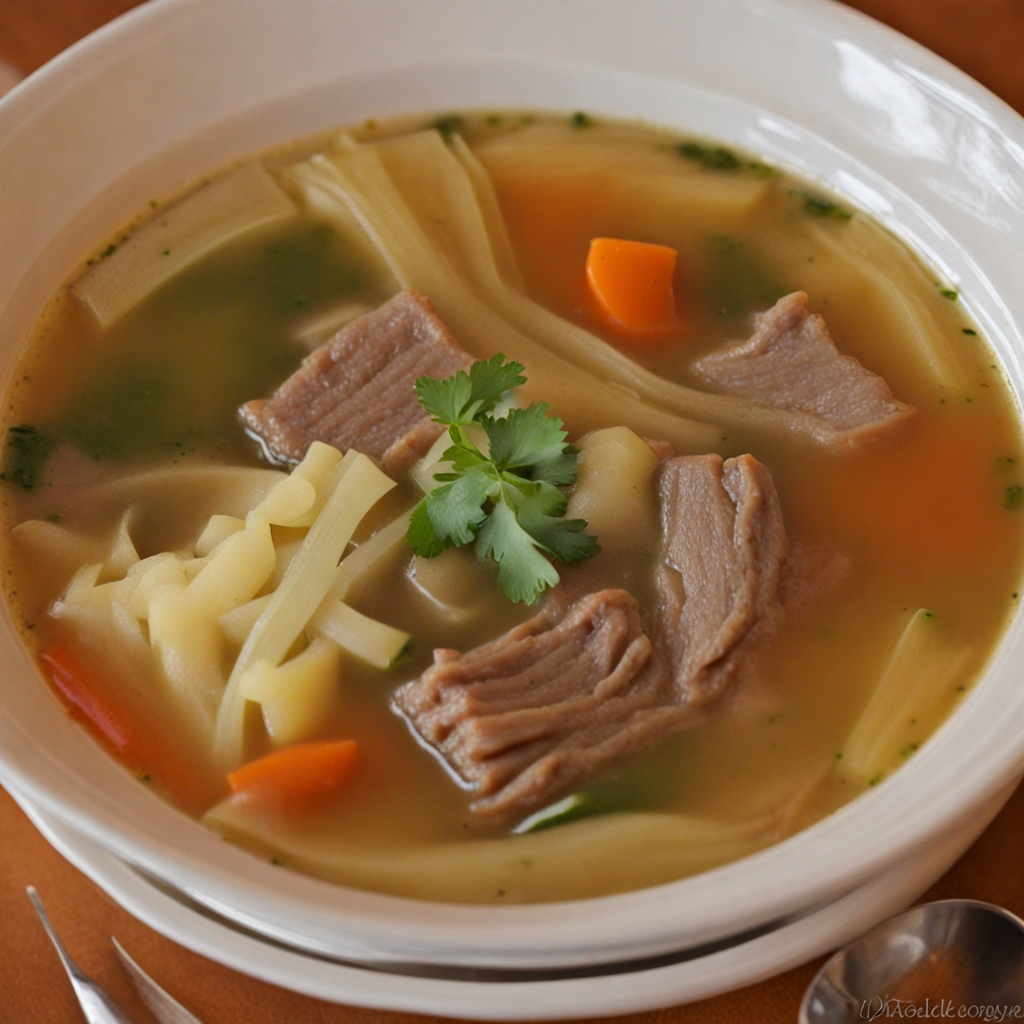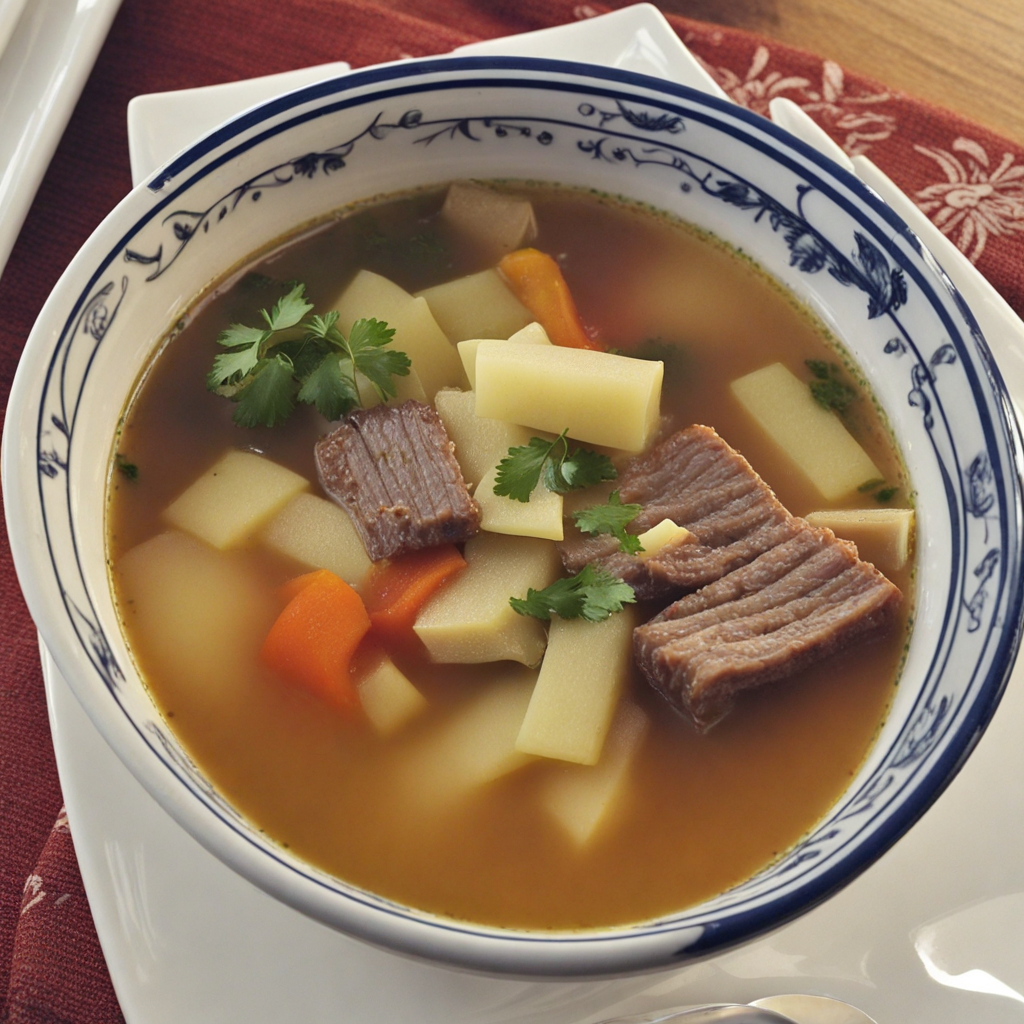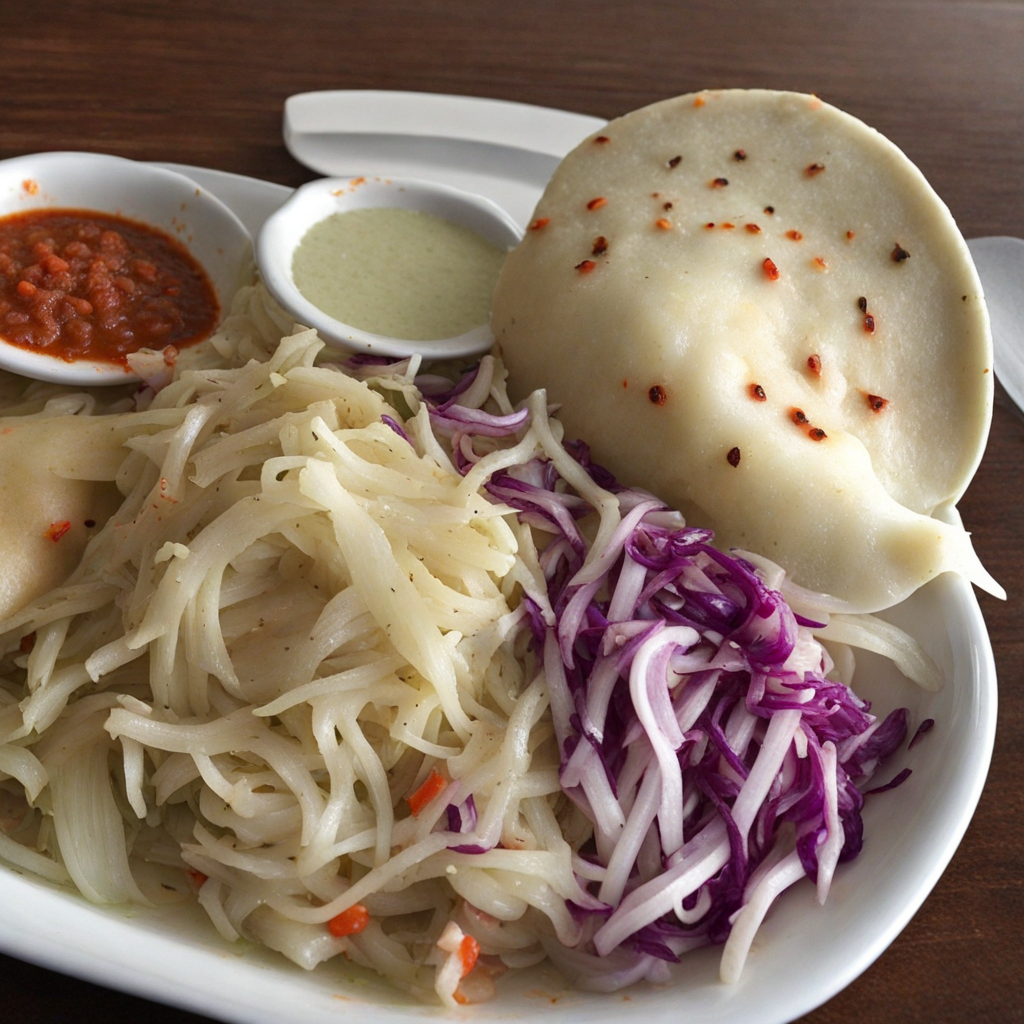Sopa de Res
Sopa de Res is a hearty beef soup that embodies the rich culinary traditions of El Salvador. This delightful dish is created by simmering tender cuts of beef, often including shank or brisket, alongside a medley of fresh vegetables such as corn, carrots, potatoes, and green beans. The slow-cooking process allows the flavors to meld beautifully, resulting in a robust broth that is both comforting and satisfying. Each spoonful offers a depth of flavor that speaks to the soul of Salvadoran cuisine, making it a popular choice for family gatherings and special occasions. What sets Sopa de Res apart is its vibrant presentation and the use of fresh herbs and spices. Cilantro, oregano, and garlic infuse the broth with aromatic notes, while the addition of lime juice at the end adds a zesty brightness that elevates the dish. Served with warm corn tortillas or rice on the side, it becomes a complete meal that nourishes both the body and spirit. The colorful assortment of vegetables not only provides a range of textures but also makes the dish visually appealing. Often enjoyed as a remedy for colds or a comfort food during rainy days, Sopa de Res is more than just a soup; it is a culinary experience that invites diners to savor each bite. The tender beef, complemented by the earthy flavors of the vegetables, creates a harmonious balance that is both filling and refreshing. For those looking to explore the tastes of El Salvador, Sopa de Res is a perfect introduction, offering a warm embrace through its rich flavors and wholesome ingredients.
How It Became This Dish
The Rich Tapestry of Sopa de Res: A Salvadoran Culinary Tradition #### Origins: A Taste of Tradition Sopa de Res, or beef soup, holds a cherished place in the culinary heritage of El Salvador. This hearty dish is not merely a meal but a reflection of the country’s history, culture, and the intermingling of indigenous and Spanish influences. Its origins can be traced back to the pre-Columbian era, when the indigenous peoples of Central America relied on a variety of local ingredients, including maize, beans, and various root vegetables, to create nourishing dishes that sustained their communities. With the arrival of Spanish colonizers in the 16th century, new ingredients and culinary techniques were introduced. Cattle ranching became a significant part of Salvadoran agriculture, influenced by Spanish livestock practices. Beef, once a rarity, became more common in the diet, gradually leading to the development of various beef dishes, including Sopa de Res. The melding of indigenous flavors with Spanish cooking methods laid the foundation for this iconic soup, which symbolizes the resilience and adaptability of Salvadoran cuisine. #### Cultural Significance: A Communal Dish Sopa de Res is more than just a comforting bowl of soup; it is a dish steeped in cultural significance. Traditionally served during family gatherings, holidays, and special occasions, it embodies the warmth of Salvadoran hospitality. The soup is often prepared in large quantities, making it ideal for sharing among family and friends. This communal aspect of the dish fosters a sense of connection and belonging, as it brings people together over a shared meal. In Salvadoran households, Sopa de Res is often enjoyed on weekends or during celebrations. It is a staple in the country's culinary repertoire, celebrated not only for its flavors but also for its nourishing properties. The ingredients—beef, vegetables, and aromatic herbs—come together to create a hearty and wholesome soup that warms both body and soul. In many ways, Sopa de Res can be seen as a metaphor for Salvadoran culture itself: diverse, resilient, and rich in tradition. #### Ingredients and Preparation: A Symphony of Flavors The beauty of Sopa de Res lies in its simplicity and versatility. While recipes may vary from family to family, the core ingredients typically include beef shank or short ribs, a medley of vegetables such as carrots, potatoes, corn, and green beans, and a blend of spices like garlic, cilantro, and oregano. Some variations may even incorporate plantains or yuca, adding depth to the dish. The preparation of Sopa de Res often begins with simmering the beef in water, allowing the flavors to meld and the meat to become tender. Once the broth is rich and infused with the essence of the beef, the vegetables are added, each contributing its unique flavor and texture. The soup is seasoned with herbs and spices, and it is not uncommon for families to have their own secret ingredients or techniques passed down through generations. Traditionally, Sopa de Res is served with a side of white rice and corn tortillas, which complement the richness of the soup and provide a satisfying balance to the meal. The act of dipping the tortillas into the soup is a cherished practice, enhancing the communal experience of enjoying the dish. #### Evolution Over Time: Resilience and Innovation As El Salvador has evolved politically, socially, and economically over the years, so too has Sopa de Res. The civil war in the 1980s brought significant changes to Salvadoran society, resulting in a diaspora that spread Salvadoran culture—and its culinary traditions—across the globe. Diaspora communities in the United States and elsewhere have kept the tradition of Sopa de Res alive, adapting recipes to incorporate locally available ingredients while maintaining the essence of the dish. In contemporary Salvadoran cooking, Sopa de Res has seen a revival among younger generations who seek to reconnect with their roots. Chefs and home cooks alike are experimenting with the soup, introducing new flavors and presentation styles while retaining the traditional elements. Food festivals and culinary events have also embraced Sopa de Res, showcasing its versatility and allowing it to shine on the global stage. Moreover, the rise of social media has provided a platform for Salvadorans to share their culinary heritage with the world. Instagram and TikTok have become avenues for showcasing the preparation of Sopa de Res, with vibrant images and videos capturing the beauty of the dish and its cultural importance. This digital renaissance has not only fostered a sense of pride among Salvadorans but has also introduced international audiences to the flavors of El Salvador. #### Sopa de Res in Modern Cuisine: A Global Connection As the world becomes increasingly interconnected, Sopa de Res has found its place in the broader conversation about global cuisine. Salvadoran restaurants in the United States and elsewhere serve Sopa de Res alongside other traditional dishes, allowing diners to explore the rich flavors of El Salvador. Food enthusiasts are drawn to the authenticity of Sopa de Res, appreciating its deep-rooted history and the story it tells about Salvadoran culture. In this globalized culinary landscape, Sopa de Res serves as a bridge between cultures, inviting people to experience the warmth and richness of Salvadoran hospitality. It has become a symbol of national identity, representing the resilience of a people who have weathered challenges while retaining their culinary traditions. #### Conclusion: A Bowl of Heritage Sopa de Res is more than just a dish; it is a narrative woven through the fabric of Salvadoran culture. From its humble origins rooted in indigenous practices to its evolution through the influences of colonization and migration, this soup encapsulates the resilience and adaptability of a nation. As generations continue to gather around the table to share this beloved dish, Sopa de Res remains a testament to the power of food to nurture, connect, and celebrate cultural heritage. In every bowl, there lies a story of tradition, community, and the enduring spirit of El Salvador.
You may like
Discover local flavors from El Salvador







